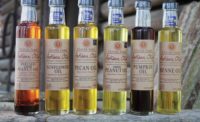Fats, Oils, Health and Functionality

New Options in Shortening Ingredients
February 2012/Prepared Foods -- Fats and oils might still be “four-letter words” to some processors. These often-misunderstood ingredients perform many different and essential—and even critical— functions in foods and in human nutrition. Today’s ingredient manufacturers are offering increasingly sophisticated “better-for-you” fat and oil systems to product developers. David Hughes, a technical services manager with Ventura Foods LLC, outlined the functional benefits of fats and provided an overview of new fat and oil ingredients during his presentation, “Next Generation of No-Trans Fat Shortenings,” during the Prepared Foods’ R&D Applications Seminar-East in 2010.
Taking a closer look at the functionality aspect of bakery shortenings, Hughes pointed out that shortening solids are triglyceride molecules that are solid at room temperature. They generally are saturated fatty acids or trans fatty acids and are critical for proper layering between dough pieces; for maintaining aeration in icings and fillings; and for maintaining crystal structure.
Hughes relayed that fats and oils:
• are a source of concentrated energy at 9 calories per gram.
• contribute essential fatty acids vital to the biological and cellular functions that drive the human body.
• provide lubricity and mouthfeel to make foods more palatable and impart a pleasurable sensory experience.
• add satiety.
• have emulsifier-carrying capabilities that allow formulation components to remain suspended in the ingredient matrix.
• are sources or transporters of fat-soluble nutrients, such as beta-carotene, omega-3 and -6 fatty acids, and the oil-soluble vitamins A, D, E and K.
• can lower water activity for safer finished products and do not readily support microbial growth.
• allow food-contact surfaces to be non-stick (anti-adhesion).
• help enrobe foods to minimize and contain moisture and, thus, extend shelflife.
• impart flavors and colors, such as butter flavor.
• function as an excellent heat-transfer medium—for example, in deep-fat and griddle frying (which also imparts unique flavors and textures).
• provide various functionalities, such as structure and aeration (through an ability to entrap air) in bakery products, especially bread, cakes and pastries.
Crystal structures typically occur in alpha, beta and beta-prime forms, Hughes explained. A correct crystal structure is critical for providing smooth, pliable shortening and margarines and “entraining” or “encapsulating” liquid oil in blends. In order to obtain the correct crystal form, the fats often require specific tempering conditions and uniform storage temperatures.
There are many different fat and oil products available to product development scientists, noted Hughes. Fats and oils come from animal and vegetable sources and may be refined, interesterified, fractionated or hydrogenated to product oils with unique characteristics. Interesterification is a process that moves fatty acids between triglycerides. Hydrogenation allows the production of fats and oils with a range of hardness, which in turn have a corresponding range of functional properties, he added. The hydrogenation process, however, produces fats in which the end-products often contain fatty acids in the trans form. Trans fatty acids are perceived as unhealthful, so researchers are looking at other products that contain low levels or are trans fatty acid-free.
Similarly, oils with elevated levels of saturated fats also are viewed negatively, so products of animal origin, such as tallow, lard and animal/vegetable oil blends, are often eliminated from the product developers’ tool box by marketing. Saturated oils sourced from plants, such as coconut and palm oils—so-called “tropical oils”—have also developed (somewhat erroneously) a bad connotation among consumers and so have been shunned by some manufacturers. Other considerations include cost of the fat or oil and availability. As an example, there are many processors who have looked at using a product such as sunflower oil, but there is, at the moment, limited supply of that item on the market.
Hughes remarked that market pressures led product developers to work with fats and oils that contain low levels of saturated fatty acids (between 20–30%) and those that contain low levels or are free of trans fatty acids. The key is to ensure these oils meet overall market demands, yet retain the functional properties needed to ensure the manufacture of foods that meet the scrutiny of consumers. Among the oils meeting these criteria are: interesterified and canola blends; soybean oils that have been blended with mono- and diglycerides; and soybean oils that have been blended with hydrogenated soy or cottonseed oil, Hughes added.
These pressures have underscored the importance of product and process development. When formulating with low-saturate shortenings, the processor must understand the whole process, from initial receipt to finished product warehousing and shipping. Of paramount importance is temperature control: Temperatures or temperature fluctuations at any point in processing have the potential to irreversibly damage saturated, low- or no-trans fats, which will adversely affect the product in which they are used.
Users of fats and oils must not only understand their products and processes, but the market in which they are operating. Issues that affect process and product development include nutritional issues, public perception, and how products are processed and handled. These same issues, plus others, will also influence which fats and oils are used and how they are used, Hughes concluded. pf
“Next Generation of No-Trans Fat Shortenings,” David Hughes, technical services manager, shortenings and oils, Ventura Foods LLC, dahughes@venturafoods.com,
www.venturafoods.com
| How Low Can You Go: Linolenic Acid |
|
There is a wide range of edible fats and oils available to food processors, and the selection is constantly expanding. Oils may be modified through traditional or innovative processes, such as interesterification. Or, they can be modified through traditional plant breeding techniques or genetic engineering, noted Beth Fulmer-Boyer, previously vice president, oil business, with Asoyia, in a presentation titled “The Lowest Linolenic Specialty Soy Oil,” given at Prepared Foods’ 2009 R&D Applications Seminar-Chicago. Edible oils are between 98-99% triglycerides. A triglyceride is a compound that has a 3-carbon glycerol backbone to which three fatty acids are attached. The type of fatty acid making up the oil determines the physical and chemical properties of the oil or fat. Fats are solid at room temperature, whereas oils are liquid. The higher the degree of unsaturated fatty acids, the lower the melting point will be. Hard fats, such as palm oil, have a greater percentage of saturated fatty acids. Unsaturated fatty acids contain double bonds that are more chemically reactive. The greater the number of double bonds, the more reactive and more prone to oxidation the molecule is; hence, the greater chance for rancidity. In addition, fats or oils with more unsaturated fatty acids are also more prone to polymerization when exposed to heat. As an example, a fat or oil with high levels of linolenic acid (18-carbon fatty acid with three double bonds) is more prone to breaking down if used for frying, explained Fulmer-Boyer. Stability of oils with high levels of unsaturated fatty acids can be achieved through the hydrogenation process. However, hydrogenation also creates trans fatty acids, recently targeted as a health issue. Another way oils high in unsaturates, especially linolenic acids, can be enhanced and stabilized is selective breeding, Fulmer-Boyer noted. This can be accomplished through traditional breeding processes or through genetic engineering. A significant percentage of the oils used in the U.S. today are products of oilseeds derived from genetically modified organisms (GMOs). There is, however, a growing demand for specialty oils that are non-GMO. Several non-GMO specialty soybean oils have been created through traditional breeding processes, Fulmer-Boyer pointed out. These two oils—proprietary, ultra-low linolenic and proprietary, mid-oleic ultra-low linolenic—have less than 1.5% linolenic acid. These oils have excellent flavor profiles and good stability. Potential applications for food processors include sauces, snack foods, baked goods, soups and topical coatings. In foodservice operations, these products can be used for deep-fat frying, stir frying, salad oils and sauces. The ultra-low linolenic oils are available with and without added TBHQ (tertiary butylhydroquinone). The addition of TBHQ improves shelflife to 9-12 months, and even up to 24 months. Field tests in deep-fat frying operations showed a 30% increase in oil life and excellent flavor profiles in the fried foods. There are many options available to oil processors to expand their product lines. This includes modification of oils through traditional or innovative processes, through traditional breeding practices or genetic engineering. There is a demand for non-GMO oils. In response to this demand, low-linolenic soybean oils have been developed that have less than 1.5% linolenic acid; excellent flavor characteristics; and perform well in both food processing and foodservice operations. pf
“The Lowest Linolenic Specialty Soy Oil,” Beth Fulmer-Boyer, previously vice president, oil business, Asoyia |
Looking for a reprint of this article?
From high-res PDFs to custom plaques, order your copy today!



